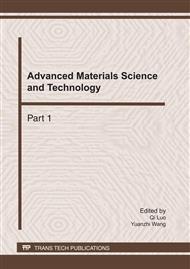[1]
S. Akhyar and S. Omayu: Neuromorphic self-tuning PID controller, in: Proc. Of IEEE Internat. Conf. on Neural Networks, (1992), p.552.
DOI: 10.1109/icnn.1993.298617
Google Scholar
[2]
S. Matsumura, S. Omatu and H. Higasa: Improvement of speed control performance using PID type neurocontroller in an electric vehicle system, in: Proc. Of IEEE Internat. Conf. on Neural Networks(1994), p.2649.
DOI: 10.1109/icnn.1994.374640
Google Scholar
[3]
S. Tzafestas and N. P. Papanikolopoulos: Incremental fuzzy expert PID control. IEEE Trans. Indust. Electronics, Vol. 37(5)( 1990), p.365.
DOI: 10.1109/41.103431
Google Scholar
[4]
Z. Y. Zhao, M. Tomizuka and S. Isaka: Fuzzy gain scheduling of PID controllers. IEEE Trans. System Man Cybernet. Vol. 23(5)( 1993), p.1392.
DOI: 10.1109/21.260670
Google Scholar
[5]
A. Visioli: Tuning of PID controllers with fuzzy logic. Proc. Inst. Elect. Eng. Contr. Theory Applicant, Vol. 148(2001), p.1.
Google Scholar
[6]
T. L. Seng, M. B. Khalid and R. Yusof: Tuning of a neuro-fuzzy controller by genetic algorithm. IEEE Trans. System Man Cybernet. B, Vol. 29(1999), p.226.
DOI: 10.1109/3477.752795
Google Scholar
[7]
P. Wang and D. P. Kwok: Optimal design of PID controllers based on genetic algorithms. Control Engrg. Practice, Vol. 2(4)( 1994), p.641.
DOI: 10.1016/0967-0661(94)90008-6
Google Scholar
[8]
b. Porter and A. H. Jones: Genetic tuning of digital PID controllers. Electronics Letters Vol. 28(1992), p.843.
DOI: 10.1049/el:19920533
Google Scholar
[9]
T. Ota and S. Omatu: Tuning of the PID control gains by GA. in Proc. of IEEE Conf. on Emerging Technology and Factory Automation(1996), p.272.
DOI: 10.1109/etfa.1996.573305
Google Scholar
[10]
J. Kennedy and R C. Eberhart: Particle swarm optimization [A]. Proceedings of IEEE International Conference on Neural Networks [C]. Piscataway, NJ: IEEE Press(1995), p. (1942).
Google Scholar
[11]
R.C. Eberhart and J. Kennedy: A new optimizer using particle swarm theory. Proceedings of the Sixth International Symposium on Micromachine and Human Science, Nagoya, Japan(1995), p.39.
DOI: 10.1109/mhs.1995.494215
Google Scholar
[12]
Y Shi and R C. Eberhart: A modified optimizer. [A]. IEEE International Conference of Evolutionary Computation. [C]. Anchorage, Alaska: IEEE Press(1998), p.69.
Google Scholar
[13]
Y Shi and R C. Eberhart: Parameter Selection in Particle Swarm Optimization [J]. Evolutionary Programming VII, Lecture Notes in Computer Science, Springer(1998), p.591.
DOI: 10.1007/bfb0040810
Google Scholar
[14]
Y Shi and R C. Eberhart: Empirical study of particle swarm optimization. Proceedings of the 1999 Congress on Evolutionary computation(1999), p. (1945).
DOI: 10.1109/cec.1999.785511
Google Scholar
[15]
Y. Mitsukura, T. Yamamoto and M. Keneda: A design of self-tuning PID controllers using a genetic algorithm [J]. in Proc. Amer. Contr. Conf., San Diego, CA(1999), p.1361.
Google Scholar
[16]
J. Kennedy and R. C. Eberhart: A discrete binary version of the particle swarm algorithm [A]. Proceedings of the World Multiconference on Systemics, Cybernetics and Informatics. Piscataway. NJ: IEEE Service Center(1997), p.4104.
DOI: 10.1109/icsmc.1997.637339
Google Scholar


